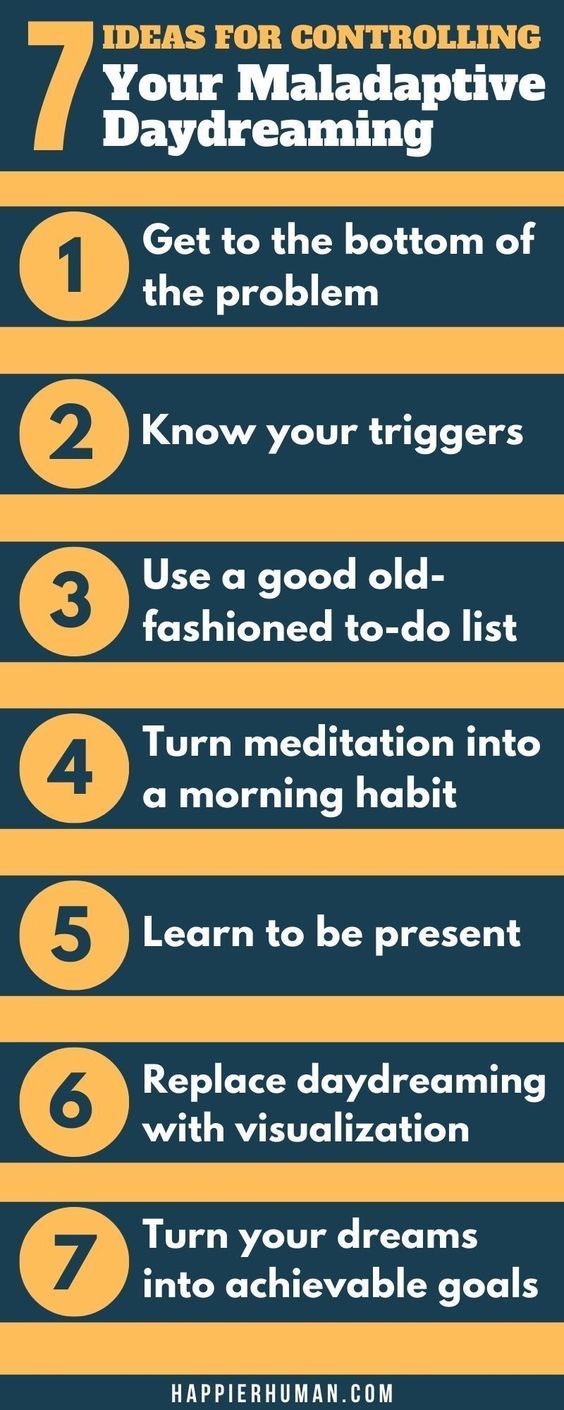There might be affiliate links on this page, which means we get a small commission of anything you buy. As an Amazon Associate we earn from qualifying purchases. Please do your own research before making any online purchase.
Have you ever noticed how our mind tends to drift whenever we have a slow day at the office?
Or perhaps you enjoy spending your free time in bed, looking at the ceiling and imagining different scenarios.
For some of us, fantasy is a way of finding creative solutions to complicated problems. Others, however, resort to maladaptive daydreaming as an alternative to the mundane aspects of reality.
While some strive to turn dreams into reality, others choose to witness how reality fades in the shadow of grand fantasies.
The point is, we all have moments when we let our imagination loose and immerse ourselves in all sorts of fantasies.
Although experts believe daydreaming is a normal and relatively healthy phenomenon, there are some who see it as a warning sign.
So, when does mind-wandering turn into maladaptive daydreaming?
Sidebar: One of the simplest ways to fix maladaptive daydreaming is to build a mindfulness practice. This year-long journal can help you make that happen.
What’s Maladaptive Daydreaming?
According to some experts, maladaptive daydreaming is “an excessive form of unwanted daydreaming that produces a rewarding experience based on a created fantasy of a parallel reality associated with a profound sense of presence.” [1]
But leaving aside ‘textbook’ definitions, maladaptive daydreaming refers to our tendency to immerse ourselves in fantasies; to escape in an imaginary world where we can be whatever we want to be or do whatever we wish to do.
And you can probably imagine how tempting it is to ‘lose yourself’ in all sorts of imaginary scenarios, especially when your reality might not be that exciting, stimulating, or rewarding.
Although clinicians have yet to determine the factors that generate this problem, some experts believe maladaptive daydreaming can occur during childhood. [2]
In other words, even from an early age, some of us learn to daydream and spend hours imagining a better version of our selves and our environment. Perhaps this coping mechanism – as maladaptive as it may be – helps us deal with the adversities that life occasionally throws down our path.
But as you can probably imagine, this strategy doesn’t solve the problem, and sooner or later, reality will slap us in the face.
Since maladaptive daydreaming isn’t listed in the Diagnostic and Statistical Manual of Mental Disorders (DSM), researchers have paid little attention to this condition.
As one 2016 paper published in Consciousness and Cognition highlights, maladaptive daydreaming is an under-researched condition that should receive more attention from the scientific community. [3]
Furthermore, some clinicians tend to have a somewhat narrower perspective. In other words, if it’s not in the DSM, it doesn’t exist. But just because maladaptive daydreaming is not recognized as a disorder, doesn’t mean there’s absolutely nothing you can do about it.
As long as you feel like it’s a behavior that affects your day-to-day life, you can explore this issue with a mental health professional and find a solution.
What Are Its Signs and Symptoms?
One of the questions that seem to be on everyone’s lips is – Where do we draw the line between healthy and maladaptive daydreaming?
On the one hand, it’s normal – even useful – to fantasize about all sorts of scenarios and maybe come up with an action plan. On the other hand, if you spend too much time fantasizing, you risk wasting time and energy on something that’s purely imaginary.
Fortunately, experts who’ve studied this condition have come up with a list of symptoms that can help you determine if you are in fact dealing with a problematic form of daydreaming.

There are several symptoms which indicate you might be dealing with maladaptive daydreaming:
- Vivid daydreams where you’re free to add any features
- Lack of focus and difficulty in completing your day-to-day tasks
- An overwhelming desire to daydream
- Exhibiting certain facial expressions or repetitive movements while daydreaming
- Whispering or talking while daydreaming
- Spending hours lost in daydreams
- Sleep problems
Although the DSM-V doesn’t recognize maladaptive daydreaming as a mental disorder, Eliezer Somer – the clinical psychologist who identified this condition – has developed a scale that measures abnormal fantasizing.
A recent study published in Consciousness and Cognition revealed that the Maladaptive Daydreaming Scale (MDS) demonstrates good validity and internal consistency. [4]
Such evaluation tools are crucial as they help clinicians diagnose this condition and suggest an appropriate course of action.
Can Maladaptive Daydreaming Lead to Depression?
Just like any other emotional or behavioral problem, maladaptive daydreaming can sometimes accompany other issues.
One study published in Frontiers in Psychiatry revealed that maladaptive daydreaming tends to accompany obsessive-compulsive symptoms. [5] In other words, our constant fantasizing may be a ritual that alleviates your intrusive thoughts.
If we think about it, people with obsessive-compulsive disorder (OCD) are preoccupied continuously with uncontrollable obsessions (thoughts and ideas) that may not have anything to do with reality. For example, if you’re dealing with a purely obsessional form of OCD, you will be inclined to spend a lot of time worrying about various worst-case scenarios. Basically, maladaptive daydreaming could be nothing more than a symptom of OCD.
Some experts believe fluvoxamine (an antidepressant used for obsessive-compulsive disorder) may be a viable treatment for maladaptive daydreaming. [6]
Another form of mental illness that may hold the answer to why we tend to engage in daydreaming is depression. For those of you who don’t know, depression is an emotional disorder that can impact our lives in a profoundly negative manner.
From a lack of energy and motivation to low self-esteem and an overall ‘grim’ perspective on life, depressive disorders can cause a lot of problems in our personal and professional life.
People who struggle with depression tend to ruminate a lot. In other words, they spend hours focusing on their negative thoughts and imagining various ‘grim’ scenarios. So just like in the case of OCD, maladaptive daydreaming could be the symptom of a broader pathology.
Long story short, there are cases when constant fantasizing is part of a psychological problem and times when maladaptive daydreaming may be a ‘stand-alone’ condition.
Does Maladaptive Daydreaming Impact Your Happiness?
We know for a fact that happiness boils down to the little things we do every day. Our day-to-day habits and the general way in which we see the world can have a profound impact on our overall sense of happiness and well-being. (Sidebar: For more about how to increase your happiness, be sure to check out this book.)
If we are to discuss maladaptive daydreaming in the context of happiness, things can get quite complicated. Can we honestly say that people who daydream are less happy and satisfied with their lives than those who choose to anchor themselves in reality?
Sadly, researchers have paid little attention to the relationship between happiness and daydreaming. However, some experts believe that daydreaming impact men and women differently. [7] For women, the vividness of daydreaming predicts lower life satisfaction whereas, for men, it’s the frequency of daydreaming that predicts lower life satisfaction.
On the other hand, the same authors highlight that daydreaming about our close ones may improve our socio-emotional well-being.
As you can see, daydreaming is a controversial topic precisely because it works like a double-edged blade. In other words, this habit can be both a massive time waster and a valuable resource. For some, daydreaming can be a source of disappointment while others use it to paint a clearer picture of the path they need to take in life.

In a way, we could argue that people who spend a lot of time daydreaming might be less happy and satisfied with their lives. Otherwise, why would they feel the need to escape in fantasies?
But what’s interesting is that daydreaming – even in its maladaptive form – can produce a sense of satisfaction. And that’s because fantasies allow us to be whomever we want to be. For a moment, the world can look precisely the way we want it to look, and that can generate happiness and joy.
What many who engage in maladaptive daydreaming fail to consider is that fantasies create a false sense of happiness. Even if the dreams are based on a ‘real’ scenario, in the end, they’re nothing more than the product of our imagination.
All and all, the way daydreaming impacts your overall sense of happiness and well-being depends mostly on why we choose to fantasize. If you engage in fantasies to escape the less-pleasant aspects of reality, then you’re probably dealing with a maladaptive form of daydreaming.
But if occasional daydreaming helps you come up with original solutions to your problems or envision a brighter future, then it can definitely serve as a valuable resource for personal and professional growth.
7 Strategies to Stop Maladaptive Daydreaming
1. Get to the bottom of the problem
As with any problematic behavior, there’s always an underlying cause that determines you to engage in maladaptive daydreaming.
Based on the content of your daydreams, you can explore the nature of this problem and discover its source.
Does the content of your daydreams have anything to do with your personal or professional life? Are you fantasizing about a scenario in which people are treating you differently? Do you spend hours thinking about ways to break up with your girlfriend/boyfriend?
On many occasions, we lose ourselves in imaginary scenarios because, for some reason, we haven’t come to terms with the less-pleasant aspects of our reality.
Once we find a way to either accept reality as it is or do something to change it, we will no longer waste our time daydreaming about an alternative version of us.
2. Know your triggers
If you tend to engage in daydreaming constantly, you’ve probably noticed a pattern. In other words, there are specific contexts in which maladaptive daydreaming tend to occur most frequently.
Some tend to fantasize when they’re bored, while others engage in daydreaming when they’re feeling stressed or disappointed. There are also people who use daydreaming a way to procrastinate on tasks they’re not particularly fond of.
Once you know your triggers, you can take specific actions to avoid falling into fantasies. For example, if you tend to daydream when you’re bored, you can make a list of activities that keep your mind focused.
Or, if you engage in daydreaming to escape stress and disappointment, you can look for alternative ways to deal with your unpleasant emotions.
Identify your triggers, and it will be way easier to get a handle on your maladaptive daydreaming.
3. Use a good old-fashioned to-do list
As I mentioned before, there are times when we daydream not because we’re unsatisfied with our reality, but because we’re bored.
You know those slow days at the office when you’re mindlessly scrolling through social media, and you see other people’s ‘perfect’ lives? That’s when your mind will slowly drift toward all sorts of fantasies where, instead of being at work, you imagine yourself on a sunny beach, living the good life.
And since we’re already established that maladaptive daydreaming does nothing more than ‘feed us’ pleasant mental images that generate a false sense of happiness, perhaps there’s a way to use our time and mental resources wisely.
Though it may sound a bit simplistic, maybe a daily to-do list will help you cut back on your daydreaming. Once you ‘push’ yourself to complete a given number of tasks per day, you will have less time to spend on fantasies.
4. Turn meditation into a morning habit
We’ve all heard of the benefits associated with meditative practices. From cultivating a state of mental calm to boosting our immune system, meditation can have a profoundly positive impact on our health and well-being.
In fact, some studies suggest that meditation can have a regulatory effect on our attentional processes. [8] In other words, people who meditate regularly experience improved focus and are less distracted by internal or external stimuli. That means they’re less prone to getting caught up in daydreams.
If you feel like daydreaming has gotten out of hand, mindfulness meditation could be an effective strategy to remain anchored in the present moment. This popular form of meditation can help you put aside past pains and future worries, thus helping you focus on the ‘here and now.’
And once your mind is fixed on the present moment, you will cease to engage in all sorts of fantasies that prevent you from getting things done.
5. Learn to be present
Being present means finding ways to anchor yourself to whatever you’re doing at a given moment. And mindfulness meditation is just one of the many ways in which you can stop living in a fantasy world and start focusing on your reality.
Another practice that can help you be more present and less distracted by daydreams is gratitude.
In essence, being grateful means showing appreciation for all the good things that are happening in your life, right now. Whether it’s a new pair of jeans or maybe a friendly “Hello” from your neighbor, being grateful for the small things reminds you of why the present moment can be just as pleasant as your fantasies.
The more you’re grateful for the little joys in life, the less you will feel the need to engage in daydreaming.
Learn to be present by being grateful for what you have right now, instead of what you may have.

6. Replace daydreaming with visualization
Since daydreaming can be a valuable resource, perhaps a good alternative to eliminating it altogether is learning to use it to our advantage.
If you think about it, there’s a small line between maladaptive daydreaming and visualizing. Unlike daydreaming, visualizing has a clear purpose and direction.
Visualization involves taking on the role of an observer; the observer of your own life. In other words, it means imagining yourself doing something or being somewhere, so that you will motivate yourself to reach that goal.
To transform maladaptive daydreaming into visualization, first, you need to choose a specific time and place to practice it. That way, you take control of the process, as opposed to letting your daydreams catch you by surprise.
Second, make sure you have a specific purpose in mind. Remember, the goal is what separates visualization from pointless daydreaming.
7. Turn your dreams into achievable goals
Visualizing a goal is one thing; planning and working to achieve it is something else. How is visualizing with ‘doing’ different from maladaptive daydreaming?
Remember that one of the reasons why we get caught up in daydreaming is that we lack purpose and direction. And that’s why you need to set achievable goals and a clear action plan for our life.
For example, instead of visualizing an overall better life, try visualizing something that would make your life better – a vacation or maybe a new career path.
Once you visualize the goals that you wish to pursue, start making plans and put in the hard work. Unlike daydreaming, which leads to a false sense of happiness, visualizing the completion of a goal contributes to authentic happiness.
Final Conclusions
Just because some experts don’t consider maladaptive daydreaming a ‘stand-alone’ condition doesn’t mean you should overlook this habit. Even if it might not be a diagnosable problem, it can be something that ‘hurts’ your productivity and makes you feel less satisfied with your ‘real’ life.
If you think you may be spending too much time lost in daydreams, try some of the strategies I shared with you earlier.
- Take the time to explore the reasons why your fantasies seem more appealing than your reality.
- Ground yourself in the present moment by being grateful for every ‘little joys’ that brighten your day.
- Turn maladaptive daydreaming in visualization by doing it with a clear purpose in mind.
The only “gain” of maladaptive daydreaming is a false sense of happiness and satisfaction. Authentic happiness is the result of an authentic life.
Finally, if you’d like to build a mindfulness habit to help you stop overthinking, then this journal can help you make that happen.
References
[1] E. Somer, L. Somer and D. S. Jopp, “Parallel lives: A phenomenological study of the lived experience of maladaptive daydreaming,” Journal of Trauma & Dissociation, vol. 17, no. 5, 2016.[2] E. Somer, L. Somer and D. S. Jopp, “Childhood Antecedents and Maintaining Factors in Maladaptive Daydreaming,” The Journal of Nervous and Mental Disease, vol. 204, no. 6, 2016.[3] J. Bigelsen, J. M. Lehrfeld, D. S. Jopp and E. Somer, “Maladaptive daydreaming: Evidence for an under-researched mental health disorder,” Consciousness and Cognition, vol. 42, 2016.[4] E. Somer, J. Lehrfeld, J. Bugelsen and D. S. Jopp, “Development and validation of the Maladaptive Daydreaming Scale (MDS),” Consciousness and Cognition, vol. 39, 2016.[5] N. Soffer-Dudek and E. Somer, “Trapped in a Daydream: Daily Elevations in Maladaptive Daydreaming Are Associated With Daily Psychopathological Symptoms,” Frontiers in Psychiatry, vol. 9, 2018.[6] C. Schupak and J. Rosenthal, “Excessive daydreaming: a case history and discussion of mind wandering and high fantasy proneness.,” Consciousness and Cognition, vol. 18, no. 1, 2009.[7] R. A. Mar, M. F. Mason and A. Litvack, “How daydreaming relates to life satisfaction, loneliness, and social support: The importance of gender and daydream content,” Consciousness and Cognition, vol. 21, no. 1, pp. 401-407, 2012.[8] A. Lutz, H. A. Slagter, J. D. Dunne and R. J. Davidson, “Attention regulation and monitoring in meditation,” Trends in Cognitive Sciences, vol. 12, no. 4, pp. 163-169, 2008.
ABOUT THE AUTHOR: Alexander Draghici is a licensed Clinical Psychologist, CBT practitioner and co-founder at psycheguide.com. His work focuses mainly on strategies designed to help people manage and prevent two of the most common mental issues – anxiety and depression.

